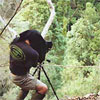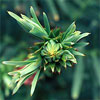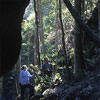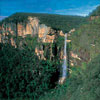
|
Previous issues
| Issue 8
| Issue 9
| Issue 10
| Issue 11
| Issue 12
| Issue 13
| Issue 14 |
Did you know?
.........................
The Wollemi Pine will be available for sale in 2005/6.
This date has been set to allow sufficient time for horticulturalists and scientists to research and cultivate the plant so as to secure the ongoing survival and conservation of this rare and threatened species.
As the 2005/6 public release of the Wollemi Pine in Australia and internationally is expected to generate widespread demand,
we encourage all potential buyers to register their interest by subscribing to the Wollemi Pine Conservation Club.
As a subscriber, you will receive Wollemi Watch - a quarterly e-newsletter covering the latest product information and research findings on the Wollemi Pine.
Closer to the release date of 2005/6, we will also provide you with details on how you will be able to purchase your own Wollemi Pine.
|
|
|
Welcome
to the fourth edition of Wollemi Watch, a quarterly online newsletter
for Wollemi Pine enthusiasts the world over.
In this first edition for 2004 we highlight a major activity for
this year which is the showcasing of the Wollemi Pine at a world-class
floriculture exhibition in Japan. We focus on the amazing work of
photographer Jaime Plaza from the Botanic Gardens Trust and reveal
his latest images from the Wollemi Pine in the wild. Feedback from
our subscribers is featured and we also uncover the story behind
the World Heritage listing of the Blue Mountains in Sydney, the
home of the Wollemi Pine wild population.
We
hope you enjoy this update and don't forget to refresh your PC wallpaper
with another fabulous Wollemi
photo here.
|
|

Newsflash:
Wollemi Pine Exhibit at Pacific Flora
The
Wollemi Pine is soon to be a key attraction at a major floriculture
exhibition in Japan, marking the first time the ancient tree species
will be on display at an exhibit outside Australia.
Pacific
Flora will be staged from April 8 to October 11 2004 on 56 hectares
beside the beautiful Lake Hamana in Hamamatsu (a city 1 hour south
of Tokyo). It is expected to attract over 5 million visitors and
showcase the best Japan and its international exhibitors have to
offer from countries including Australia, the United States, the
United Kingdom, Canada, China, Germany, the Netherlands, and Korea.
Wollemi
Pines have been presented to the Shizuoka International Garden and
Horticulture Exhibition (the organisation coordinating Pacific Flora
2004) to provide the opportunity for Japanese people to support
the worldwide conservation and repopulation of the Pine. It is planned
that one Wollemi Pine will be part of an indoor exhibit and another
will be featured outdoors in the "Horticultural Gardens".
A
planting ceremony will take place at the Pacific Flora site on March
23 to commemorate the Wollemi Pine exhibit at Pacific Flora. Organisers
believe it will be a fitting addition to Pacific Flora 2004 which
is themed "Flowers, Greenery, Water: Creating New Style of
Living". The theme will encourage participants and visitors
to the exhibition to take a fresh look at the relationship between
human society and the natural world and build a better and brighter
future.
Pacific
Flora will feature attractions such as a re-creation of a Flower
Museum (Monet's House & Monet's Garden), displays of Surprising
Plants from Around the World, a 5 metre high floral Mt Fuji, and
a three-dimensional garden in the shape of a 13-meter-high cylinder
created by famous Japanese designer Kansai Yamamoto.
It
is anticipated that there will be significant interest in the Wollemi
Pine from the Japanese people based on their interest in rare and
ancient plants and the symbolic nature of conifers in the national
culture. The Wollemi Pine will be available in Japan via specialist
retail outlets by early 2006.
|

Behind
the Scenes with Jaime Plaza
Jaime
Plaza van Roon is the Senior Photographer at the Botanic Gardens
Trust and has been responsible for photographing the Wollemi Pine
in situ for the past 10 years. He photographed the Wollemi Pine
in 1994 before it was even officially identified and has since visited
the wild population twice a year to document the trees for scientific
purposes.
To
meet researcher requirements, Jaime takes detailed photographs of
the Wollemi Pine's physical characteristics like leaves, branches,
cones and bark. A major part of his work is photographing the trees'
cone development over time so researchers can build up a picture
of the reproductive cycle and are able to determine the number and
position of male and female cones produced on each tree from year
to year.
Jaime's
work is no mean feat considering the remote location of the Wollemi
Pine in the wild. To get to the site initially, Jaime was required
to fly in by helicopter and, with no landing pad nearby, was winched
down onto a nearby cliff. Ropes were then used to climb down with
all the necessary photographic equipment from the top of the canyon
to a suitable ledge.
"In
those early visits, I was required to not only photograph the Wollemi
Pine site but also help with the process of seed collection by setting
up seed traps. Very few of us are allowed into the wild population
and the trips are so limited that it's all hands on deck when we
get there," said Jaime.
"There
is also only limited time in the day suitable to take photographs,
because the trees are in a narrow shaded canyon. The ideal situation
is absolutely still, with no wind, and just slightly overcast, but
that doesn't always happen."
"Although
there's a lot of waiting for that precise moment, I really enjoy
the work and feel it is such a privilege to witness the pristine
and untouched environment in which the wild Wollemi Pines live.
There are very few signs of human disturbance at the site. I have
not even seen flies there."
Over
the years, Jaime has developed an extensive photo library of the
Wollemi Pine, and many of his photos are available at the Wollemi
Pine photo gallery. He normally uses medium format - Mamiya
and Arca Swiss camera outfits with lenses ranging from 58 mm to
450 mm. While this outfit is big and slow, the benefit is a larger
area of image that needs less enlargement at the scanning stage.
For 35 mm photographs, he uses Leica and Nikon camera outfits with
lenses ranging from 20 mm to 200 mm.
Jaime
was born in Chile and migrated to Australia in 1986. Through his
photography, he has found an ideal outlet for his life long interest
in nature and the environment. He has had photographic assignments
for organisations such as the Museum of Sydney, National Museum
of Australia, Historic Houses Trust, ACP Publishing, and New Holland
Publishers. His photographs have also been extensively published
in Australia, Europe and the United States through Auscape
International (an Australian Photo Library and Agency).
Stay
tuned to hear more about people like Jaime who are working to conserve
and protect the Wollemi Pine for current and future generations
to enjoy.
|

Did
You Know: Wollemi Pines Can Detox Your Home or Office?
Did you know that indoor air pollution can be 20 to 100 times the
level of outdoor air pollution?! For city dwellers who spend around
90% of their time indoors, indoor air quality is a worrying health
issue.
The
good news is that research has emerged in recent years from both
Australia and the United States showing that indoor pot plants are
sophisticated pollution absorbing devices. Specifically, plants
from the Araucaria family (e.g. the Norfolk Island Pine), of which
the Wollemi Pine is a member, have been hailed as some of the most
effective and efficient plants for detoxing indoor environments.
Research
in the US published by NASA and the Associated Landscape Contractors
of America (ALCA) found that living plants are so efficient at absorbing
contaminants in the air that some will be launched into space as
part of the biological life support system aboard future orbiting
space stations.
Led
by Dr. Bill Wolverton (a former NASA research scientist), the research
claims that the indoor air pollutants are common in newly built
or recently renovated buildings. Chemicals from the paint, carpets,
and furniture are usually responsible for the toxicity levels. Tightly
sealed buildings, made to be efficient at heating and cooling, also
re-circulate toxic fumes causing complaints such as sore throats,
headaches and frequent colds.
"Plants
are the lungs of the planet. They humidify and purify the air. So
we can use plants to turn our homes and offices into healthy ecosystems,
that purify and cleanse themselves," said Dr Wolverton.
As
the Wollemi Pine is proving to be an excellent indoor plant (it
grows well in low light and air conditioned environments), it now
goes to show that having a Wollemi Pine will not only beautify your
home or office but will also improve your health.
|

Wollemi
Pine Conservation Club: Subscriber Feedback
Wollemi
Pine enthusiasts worldwide have been signing up to the Wollemi Pine
Conservation Club to register their interest in acquiring a Wollemi
Pine. Here are just a few of the latest remarks that we have received.
"Your
work on the Wollemi Pine is of great service to our understanding
of earth's natural history and will hopefully raise awareness on
the importance of preserving the fragile natural environment common
to us all."
Home Gardener, Switzerland
"I
would love our students to have the opportunity to grow one of these
very special trees and observe its growth and development."
Teacher, Australia
"Clearly
one of the most beautiful tree species ever seen as well as one
of the most botanically fascinating. Should be grown by plant lovers
everywhere!"
Home Gardener, California
"I
think this is one of the most extraordinary finds and to have this
Wollemi plant in my house would be like having a visitor from another
planet."
Home Gardener, Germany
"The
tree will be a gift for my sister and brother-in-law to plant in
the yard of their new home."
Home Gardener, Ontario
"I
learned of Wollemia via the (London) Times first press release years
ago. I appreciate learning of its potential for a houseplant in
the January 2004 RHS journal, 'The Garden'."
Home Gardener, Idaho
"I
am fascinated by earth's history - to have something like this is
like a time warp in my own house - how exciting!!"
Home Gardener, Quebec
"I'm
studying horticulture and will probably be teaching Botany and Soil
Science next fall. I'm excited about the discovery of the Wollemi
Pine. There is a magnificent specimen of the Dawn Redwood, another
"fossil" plant, in my neighborhood."
Teacher, North Carolina
"This
is a great way to preserve the tree by getting people all around
the globe to help."
Home Gardener, Malta
"The
story of this tree is too incredible for fiction - I'd like to contribute
to ensuring it's survival by planting a few of them on the 3 acres
I have next to my house in Oxfordshire."
Home Gardener, Oxfordshire
See
more frequently asked questions
Joining
the Wollemi Pine Conservation Club registers your interest
in purchasing a Wollemi Pine when they are released in 2005/6.
|

Fact
File: Wollemi Pine Behind Blue Mountains World Heritage Listing
The remarkable discovery of the Wollemi Pine in the Greater Blue
Mountains Area was a key factor in the area being inscribed on the
World Heritage List at the 24th Session of the World
Heritage Committee in December 2000. The 200 million year history
of the relic Wollemi Pine, its evolutionary success and its status
as a threatened species all contributed to building the case for
why its home in the Greater Blue Mountains Area must be recognised
and preserved as one of the world's top natural environments.
The
Greater Blue Mountains Area consists of 1.03 million hectares of
mostly forested landscape on sandstone plateaux, escarpments and
gorges 60 to 180 kilometres inland from central Sydney, New South
Wales. The area includes vast expanses of wilderness and is equivalent
in area to almost one third of Belgium, or twice the size of Brunei.
It is comprised of seven outstanding national parks including the
Blue Mountains, Wollemi (where the Wollemi Pine was discovered),
Yengo, Nattai, Kanangra-Boyd, Gardens of Stone and Thirlmere Lakes
National Parks.
A
major feature of the Blue Mountains is its dense population of oil
bearing Eucalyptus trees which are said to reflect a blue colour
into the atmosphere. It is also an area of breathtaking views, rugged
tablelands, sheer cliffs, deep, inaccessible valleys and swamps
teeming with life. The unique plants and animals that live in the
area relate a story of Australia's antiquity, its diversity of life
and its rugged beauty.
The
Greater Blue Mountains Area is famous for containing ancient, relict
species of global significance. The Wollemi Pine is the most famous
of these as it is considered a "living fossil" dating
back to the age of the dinosaurs. It is also home to more than 400
different kinds of animals, many of which are threatened or rare
species of conservation significance such as the spotted-tailed
quoll, the koala, and the yellow-bellied glider.
The
Greater Blue Mountains Area affords representation of a major component
of global biodiversity not previously represented on the World Heritage
List. In fact, it represents the highest biodiversity in temperate
forest environments, in Australia and globally, both within and
across taxonomic levels. The Area includes almost ten percent of
the Australian vascular plant flora and is outstanding on a global
scale for its biodiversity.
For
more information on the Greater Blue Mountains Area, please visit
www.bluemountainstourism.org.au
Want
to experience the Wollemi Wilderness? Download
your own Wollemi wallpaper >> Click
Here
|
|
| Photos:
Jaime Plaza (Botanic Gardens Trust) and Blue Mountains Tourism |
|
|

|


